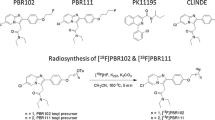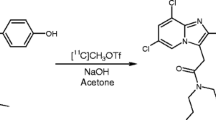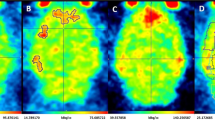Abstract
Purpose
We aimed to characterize pharmacologically the TSPO- radioligand [18F]DPA-714 in the brain of healthy cynomolgus monkeys and evaluate the cellular origin of its binding in a model of neurodegeneration induced by intrastriatal injection of quinolinic acid (QA).
Methods
[18F]DPA-714 PET images were acquired before and at 2, 7, 14, 21, 49, 70, 91 days after putaminal lesioning. Blocking and displacement studies were carried out (PK11195). Different modelling approaches estimated rate constants and V T (total distribution volume) which was used to measure longitudinal changes in the lesioned putamen. Sections for immunohistochemical labelling were prepared at the same time-points to evaluate correlations between in vivo [18F]DPA-714 binding and microglial/astrocytic activation.
Results
[18F]DPA-714 showed a widespread distribution with a higher signal in the thalamus and occipital cortex and lower binding in the cerebellum. TSPO was expressed throughout the whole brain and about 73 % of [18F]DPA-714 binding was specific for TSPO in vivo. The one-tissue compartment model (1-TCM) provided good and reproducible estimates of V T and rate constants, and V T values from the 1-TCM and the Logan approach were highly correlated (r 2 = 0.85). QA lesioning induced an increase in V T, which was +17 %, +54 %, +157 % and +39 % higher than baseline on days 7, 14, 21 and 91 after QA injection, respectively. Immunohistochemistry revealed an early microglial and a delayed astrocytic activation after QA injection. [18F]DPA-714 binding matched TSPO immunopositive areas and showed a stronger colocalization with CD68 microglia than with GFAP-activated astrocytes.
Conclusion
[18F]DPA-714 binds to TSPO with high specificity in the primate brain under normal conditions and in the QA model. This tracer provides a sensitive tool for assessing neuroinflammation in the human brain.








Similar content being viewed by others
References
Glass CK, Saijo K, Winner B, Marchetto MC, Gage FH. Mechanisms underlying inflammation in neurodegeneration. Cell. 2010;140:918–34.
Faideau M, Kim J, Cormier K, Gilmore R, Welch M, Auregan G, et al. In vivo expression of polyglutamine-expanded huntingtin by mouse striatal astrocytes impairs glutamate transport: a correlation with Huntington’s disease subjects. Hum Mol Genet. 2010;19:3053–67.
Hirsch EC, Vyas S, Hunot S. Neuroinflammation in Parkinson’s disease. Parkinsonism Relat Disord. 2012;18 Suppl 1:S210–2.
Wyss-Coray T. Inflammation in Alzheimer disease: driving force, bystander or beneficial response? Nat Med. 2006;12:1005–15.
Papadopoulos V, Baraldi M, Guilarte TR, Knudsen TB, Lacapere JJ, Lindemann P, et al. Translocator protein (18 kDa): new nomenclature for the peripheral-type benzodiazepine receptor based on its structure and molecular function. Trends Pharmacol Sci. 2006;27:402–9.
Venneti S, Lopresti BJ, Wiley CA. The peripheral benzodiazepine receptor (Translocator protein 18 kDa) in microglia: from pathology to imaging. Prog Neurobiol. 2006;80:308–22.
Chen MK, Guilarte TR. Translocator protein 18 kDa (TSPO): molecular sensor of brain injury and repair. Pharmacol Ther. 2008;118:1–17.
Chauveau F, Boutin H, Van Camp N, Dolle F, Tavitian B. Nuclear imaging of neuroinflammation: a comprehensive review of [11C]PK11195 challengers. Eur J Nucl Med Mol Imaging. 2008;35:2304–19.
Dolle F, Luus C, Reynolds A, Kassiou M. Radiolabelled molecules for imaging the translocator protein (18 kDa) using positron emission tomography. Curr Med Chem. 2009;16:2899–923.
Chauveau F, Van Camp N, Dolle F, Kuhnast B, Hinnen F, Damont A, et al. Comparative evaluation of the translocator protein radioligands 11C-DPA-713, 18F-DPA-714, and 11C-PK11195 in a rat model of acute neuroinflammation. J Nucl Med. 2009;50:468–76.
Damont A, Hinnen F, Kuhnast B, Schöllhorn-Peyronneau M, James M, Luus C, et al. Radiosynthesis of [18F]DPA-714, a selective radioligand for imaging the translocator protein (18 kDa) with PET. J Labelled Comp Radiopharm. 2008;51:286–92.
James ML, Fulton RR, Vercoullie J, Henderson DJ, Garreau L, Chalon S, et al. DPA-714, a new translocator protein-specific ligand: synthesis, radiofluorination, and pharmacologic characterization. J Nucl Med. 2008;49:814–22.
Martin A, Boisgard R, Theze B, Van Camp N, Kuhnast B, Damont A, et al. Evaluation of the PBR/TSPO radioligand [(18)F]DPA-714 in a rat model of focal cerebral ischemia. J Cereb Blood Flow Metab. 2010;30:230–41.
Arlicot N, Vercouillie J, Ribeiro MJ, Tauber C, Venel Y, Baulieu JL, et al. Initial evaluation in healthy humans of [18F]DPA-714, a potential PET biomarker for neuroinflammation. Nucl Med Biol. 2012;39:570–8.
Brouillet E, Conde F, Beal MF, Hantraye P. Replicating Huntington’s disease phenotype in experimental animals. Prog Neurobiol. 1999;59:427–68.
Ferrante RJ, Kowall NW, Cipolloni PB, Storey E, Beal MF. Excitotoxin lesions in primates as a model for Huntington’s disease: histopathologic and neurochemical characterization. Exp Neurol. 1993;119:46–71.
Kuhnast B, Damont A, Hinnen F, Catarina T, Demphel S, Le Helleix S, et al. [18F]DPA-714, [18F]PBR111 and [18F]FEDAA1106-selective radioligands for imaging TSPO 18 kDa with PET: automated radiosynthesis on a TRACERLAb FX-FN synthesizer and quality controls. Appl Radiat Isot. 2012;70:489–97.
Zhang MR, Kumata K, Maeda J, Yanamoto K, Hatori A, Okada M, et al. 11C-AC-5216: a novel PET ligand for peripheral benzodiazepine receptors in the primate brain. J Nucl Med. 2007;48:1853–61.
Peyronneau MA, Saba W, Goutal S, Damont A, Dolle F, Kassiou M, et al. Metabolism and quantification of [(18)F]DPA-714, a new TSPO positron emission tomography radioligand. Drug Metab Dispos. 2013;41:122–31.
Rivière D, Papadopoulos-Orfanos D, Régis J, Mangin JF. A structural browser of brain anatomy. Human Brain Mapping. San Antonio. Neuroimage; 2000.
Innis RB, Cunningham VJ, Delforge J, Fujita M, Gjedde A, Gunn RN, et al. Consensus nomenclature for in vivo imaging of reversibly binding radioligands. J Cereb Blood Flow Metab. 2007;27:1533–9.
Logan J, Fowler JS, Volkow ND, Wolf AP, Dewey SL, Schlyer DJ, et al. Graphical analysis of reversible radioligand binding from time-activity measurements applied to [N-11C-methyl]-(−)-cocaine PET studies in human subjects. J Cereb Blood Flow Metab. 1990;10:740–7.
Akaike H. A new look at the statistical model identification. IEEE Trans Autom Contr. 1974;AC19:716–23.
Carson RE. Parameter estimation in positron emission tomography. In: Phelps ME, Mazziotta JC, Schelbert HR, editors. Positron emission tomography and autoradiography: principles and applications for the brain and heart. New York: Raven; 1986. p. 347–9.
Dauguet J, Delzescaux T, Conde F, Mangin JF, Ayache N, Hantraye P, et al. Three-dimensional reconstruction of stained histological slices and 3D non-linear registration with in-vivo MRI for whole baboon brain. J Neurosci Methods. 2007;164:191–204.
Doorduin J, Klein HC, Dierckx RA, James M, Kassiou M, de Vries EF. [11C]-DPA-713 and [18F]-DPA-714 as new PET tracers for TSPO: a comparison with [11C]-(R)-PK11195 in a rat model of herpes encephalitis. Mol Imaging Biol. 2009;11:386–98.
Martin A, Boisgard R, Kassiou M, Dolle F, Tavitian B. Reduced PBR/TSPO expression after minocycline treatment in a rat model of focal cerebral ischemia: a PET study using [(18)F]DPA-714. Mol Imaging Biol. 2011;13:10–5.
Lavisse S, Guillermier M, Herard AS, Petit F, Delahaye M, Van Camp N, et al. Reactive astrocytes overexpress TSPO and are detected by TSPO positron emission tomography imaging. J Neurosci. 2012;32:10809–18.
Rao VL, Butterworth RF. Characterization of binding sites for the omega3 receptor ligands [3H]PK11195 and [3H]RO5-4864 in human brain. Eur J Pharmacol. 1997;340:89–99.
Zhang MR, Maeda J, Ogawa M, Noguchi J, Ito T, Yoshida Y, et al. Development of a new radioligand, N-(5-fluoro-2-phenoxyphenyl)-N-(2-[18F]fluoroethyl-5-methoxybenzyl)acetamide, for PET imaging of peripheral benzodiazepine receptor in primate brain. J Med Chem. 2004;47:2228–35.
Imaizumi M, Briard E, Zoghbi SS, Gourley JP, Hong J, Fujimura Y, et al. Brain and whole-body imaging in nonhuman primates of [11C]PBR28, a promising PET radioligand for peripheral benzodiazepine receptors. Neuroimage. 2008;39:1289–98.
Imaizumi M, Briard E, Zoghbi SS, Gourley JP, Hong J, Musachio JL, et al. Kinetic evaluation in nonhuman primates of two new PET ligands for peripheral benzodiazepine receptors in brain. Synapse. 2007;61:595–605.
Saba W, Peyronneau MA, Goutal S, Damont A, Dollé F, Tournier N, et al. Inhalation of cigarette smoke decreases the binding of [18F]DPA-714 to 18 kDa translocator protein (TSPO) in several tissues: a PET study in baboons. In: Proceedings of the EANM'12 Annual Congress of the European Association of Nuclear Medicine, Milan, 2012
Tsukada H, Nishiyama S, Ohba H, Kanazawa M, Kakiuchi T, Harada N. Comparing amyloid-beta deposition, neuroinflammation, glucose metabolism, and mitochondrial complex I activity in brain: a PET study in aged monkeys. Eur J Nucl Med Mol Imaging. 2014;41:2127–36.
Coughlin JM, Wang Y, Ma S, Yue C, Kim PK, Adams AV, et al. Regional brain distribution of translocator protein using [(11)C]DPA-713 PET in individuals infected with HIV. J Neurovirol. 2014;20:219–32.
Owen DR, Gunn RN, Rabiner EA, Bennacef I, Fujita M, Kreisl WC, et al. Mixed-affinity binding in humans with 18-kDa translocator protein ligands. J Nucl Med. 2011;52:24–32.
Dihne M, Block F, Korr H, Topper R. Time course of glial proliferation and glial apoptosis following excitotoxic CNS injury. Brain Res. 2001;902:178–89.
Moresco RM, Lavazza T, Belloli S, Lecchi M, Pezzola A, Todde S, et al. Quinolinic acid induced neurodegeneration in the striatum: a combined in vivo and in vitro analysis of receptor changes and microglia activation. Eur J Nucl Med Mol Imaging. 2008;35:704–15.
Brickell KL, Nicholson LF, Waldvogel HJ, Faull RL. Chemical and anatomical changes in the striatum and substantia nigra following quinolinic acid lesions in the striatum of the rat: a detailed time course of the cellular and GABA(A) receptor changes. J Chem Neuroanat. 1999;17:75–97.
Dusart I, Marty S, Peschanski M. Glial changes following an excitotoxic lesion in the CNS – II. Astrocytes. Neuroscience. 1991;45:541–9.
Marty S, Dusart I, Peschanski M. Glial changes following an excitotoxic lesion in the CNS – I. Microglia/macrophages. Neuroscience. 1991;45:529–39.
Ryu JK, Choi HB, McLarnon JG. Peripheral benzodiazepine receptor ligand PK11195 reduces microglial activation and neuronal death in quinolinic acid-injected rat striatum. Neurobiol Dis. 2005;20:550–61.
Acknowledgments
We are grateful to: Marion Chaigneau and Diane Houitte for expert technical assistance with animal handling, Yoan Fontyn and Léopold Eymin for reconstruction of PET data, and Stéphane Demphel, Stéphane Le Helleix and Tony Catarina for radioligand synthesis. We thank Albertine Dubois and Thierry Delzescaux for their respective assistance with various aspects of the VOI segmentation and 3D iconographic rendering. We also warmly thank Dr. Emmanuel Brouillet and Dr. Michel Bottlaender for stimulating discussions on the project and on the manuscript.
One author (K.I.) was supported in parts by the Canon Foundation Europe, and the Mochida Memorial Foundation for Medical and Pharmaceutical Research. This work was also partly supported by European Framework Programme 7 STEMS programme (LHSB-CT-2006-037328) and by the Agence Nationale de Recherche 2010-RFCS-003 (HD-SCT).
Conflicts of Interest
None.
Author information
Authors and Affiliations
Corresponding author
Additional information
S. Lavisse and K. Inoue contributed equally to this work.
Electronic supplementary material
Below is the link to the electronic supplementary material.
Fig 1
Microscopic examination of putamen sections immunostained for NeuN, TSPO, Iba1, CD68, GFAP and S100β in the intact (baseline) putamen and 1, 2, 7, 14, 21, 40, 49 and 91 days after QA injection (scale bar 50 μm)
Rights and permissions
About this article
Cite this article
Lavisse, S., Inoue, K., Jan, C. et al. [18F]DPA-714 PET imaging of translocator protein TSPO (18 kDa) in the normal and excitotoxically-lesioned nonhuman primate brain. Eur J Nucl Med Mol Imaging 42, 478–494 (2015). https://doi.org/10.1007/s00259-014-2962-9
Received:
Accepted:
Published:
Issue Date:
DOI: https://doi.org/10.1007/s00259-014-2962-9




